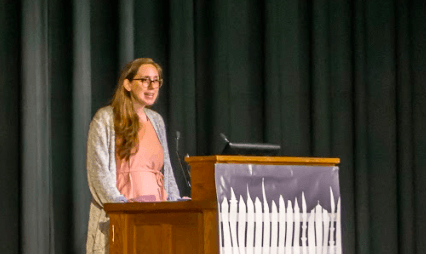Reporter Emma Green gives a presentation about the Catholic Church at this week
Staff writer for the Atlantic Emma Green enlightened audience members on the Catholic Church through stories of individuals she has encountered throughout her career.
Green’s work typically follows the trends of religion, politics
Rather than simply regurgitate facts, Green’s journalistic background allowed her to tell the audience moving stories of people she met that showed the many versions of what Catholicism in America looked like. The theme of her lecture was her belief that today’s Catholics are being “squeezed.”
“They’re squeezed from different directions in terms of their abilities to fit within religious life,” said Green. “They’re being squeezed in terms of our political culture and the expectations our politicians have around certain types of issues.”
The first story she told was of Jack Connors, an influential businessman and political advisor in Boston. Despite being a lifelong Catholic, Connors felt betrayed by the Catholic Church after the Spotlight investigation into sex abuse in the Catholic Archdiocese of Boston. What frustrated Connors about the scandal was that people were still focused on the failure and dysfunction of the Catholic Church to hold its clergymen accountable even 17 years after the investigation.
“I believe that we’re in a time of significant disillusionment, which has been going on for quite some years with those people who do lead the institutional Catholic Church,” she said.
The second person Green spoke about was Rusty Reno, editor of the “small but mighty” Catholic magazine First Things. Reno, as Green describes, represents a segment of American Catholic life that perceives their place in society as one of embattlement. He believes that current cultural perceptions of Catholicism, as well as the shift in ideals away from traditional Catholic teachings, has begun ejecting Catholicism out of public society.
Despite his beliefs that the Trump administration has been making progress to reinstall those beliefs into the mainstream American zeitgeist, Reno still fears that people’s religious liberties are in peril.
“I think he represents an impulse in Catholic life, that seeks a greater Orthodoxy in a time of perceived rising progressivism, one that seeks defenses for traditional points of view and the ability of people to live out those traditional points of view,” Green said.
Next, Green talked about Pamela Maraldo, a practicing Catholic who briefly served as the president of Planned Parenthood in the mid-’90s. Maraldo, who came from a nursing background, wanted to “pivot the ship” of Planned Parenthood’s brand of abortion towards a big tent brand of healthcare. Despite being pro-choice herself, Maraldo acknowledged that taking that sort of stance might not resonate with most Americans, who she deemed as largely being “mainstream centrists.”
This was a notion that Green saw as radical, who saw views of abortion as a bifurcation into two sides with very little room for nuance or middle ground. When reviewing polling data, Green noted that party affiliation mattered more than religious affiliation when determining their stance on hot-button issues– proof that Catholics are changing to mirror the polarization of American life and politics.
“I do think that no matter who wins the White House, who takes the Senate, who keeps the House or takes the House, we are going to continue seeing this trend of moving into two camps and the elimination of middle space,” Green said.
The last story she told was of Catrin Almako, a mother from Detroit who came over from Iraq with her family after ISIS invaded her homeland on the Nineveh Plain. Green proclaims that while they are not from America originally, their story is largely representative of the American Dream.
“It’s about being able to come to the United States, settle here because the place that you live feels untenable, and build a life as Americans,” said Green.
As members of the Chaldean Catholic Church, which largely consists of Catholics of Middle Eastern descent, Almako and others like her often find themselves as political objects trapped between two constituencies– one that values religious freedom, while the other champions immigrants and refugees. While there is so much “political firepower” towards Catholics in these regions, these populations are also the threat of deportations under the Trump administration.
Regardless, Green notes that the future of the Catholic Church lies within these historically white churches being lead and upheld by immigrant populations. She particularly notes the large Chaldean population in Detroit, the Los Angeles Cathedral, and even parishes in Rhode Island.
“The future of the Church is an immigrant church,” Green said. “It’s a mission field where the pews are emptying and greying, and the life of the Church is really centered elsewhere, and that life is coming here.”





